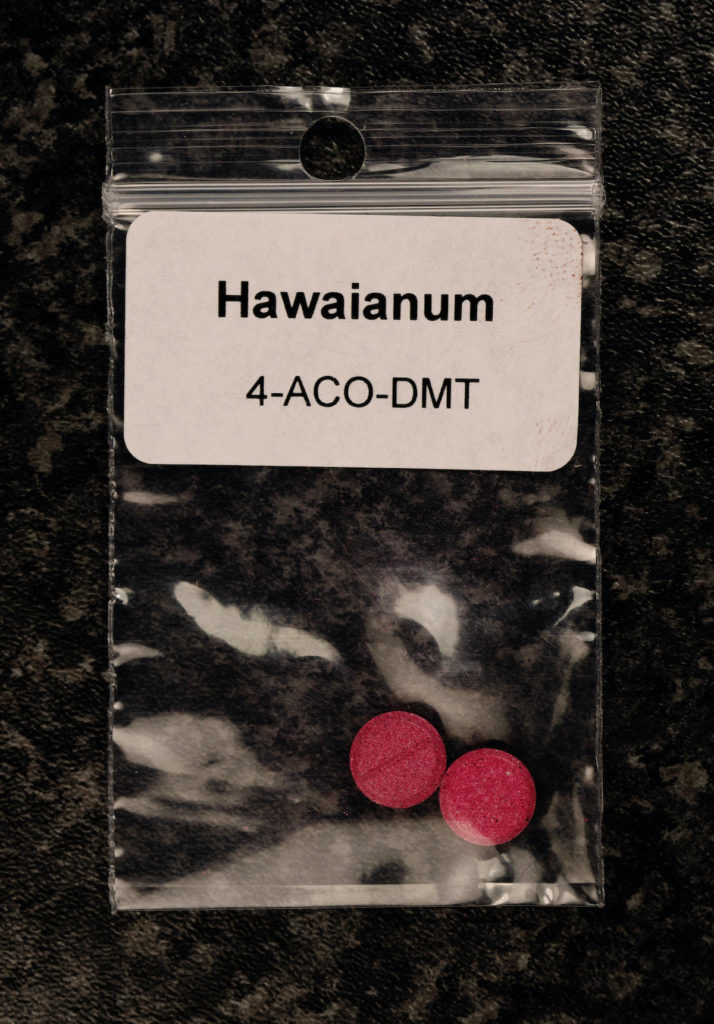4-ACO-DMT – Legality, Dosage, Safety & More
4-AcO-DMT (4-Acetoxy-N,N-dimethyltryptamine) is a synthetic psychedelic compound. People often refer to it as “synthetic mushrooms” due to it producing subjective effects nearly identical to those of psilocybin mushrooms. 4-AcO-DMT’s chemical structure is also similar to that of psilocin, the psychoactive compound that psilocybin turns into when processed by the body.
As a novel psychoactive compound, 4-AcO-DMT exists in a legal grey area in many countries. In some countries, the substance is legal while in others it is explicitly illegal.
This guide will explore various aspects of 4-AcO-DMT, including its chemistry, pharmacology, history, and effects. We will then look at the legal status of 4-AcO-DMT across the world.
RELATED: What Does ‘Set And Setting’ Mean When Using Psychedelics?
What Is 4-AcO-DMT?

4-AcO-DMT is a tryptamine psychedelic, meaning it has the basic element of tryptamine known as the indole structure. Tryptamine itself is a compound that exists throughout nature. It is derived from the essential amino acid tryptophan.
Other tryptamine psychedelics include psilocybin, psilocin, ibogaine, bufotenin, DMT, and 5-MeO-DMT.
4-AcO-DMT is not found in nature. The drug can only be made in a lab.
How 4-AcO-DMT Causes A Psychedelic Experience
4-AcO-DMT is a structural analog of the psychedelic compound psilocybin, meaning they both have a similar chemical structure.
Like psilocybin, it is thought that 4-AcO-DMT acts as a prodrug to psilocin, meaning that when the body processes it, it breaks down into psilocin, which is responsible for magic mushrooms’ subjective effects. The psychedelic researcher David E. Nichols suggested this in 1999.
We don’t know how the body metabolizes 4-AcO-DMT. However, based on the chemistry and metabolism of similar tryptamines, it is reasonable to assume that this substance undergoes deacetylation in the body (where an acetyl group is removed from the molecule), forming psilocin.
From that point on, the psilocin would then bind to the serotonin 5-HT2A receptors in the brain. This results in psychedelic effects that many people find indistinguishable from those caused by shrooms.
It may be possible, nonetheless, that 4-AcO-DMT is psychoactive on its own. If so, when you ingest the compound, it would bind to serotonin receptors, including 5-HT2A receptors, eliciting a psychedelic effect. And this effect may be unique, different from psilocin in some way. Indeed, some users report that the 4-AcO-DMT experience is not exactly the same as the psilocybin experience.
RELATED: Legal Psychedelics: The U.S. Cities Where Psilocybin, LSD And Others Are Decriminalized
The History of 4-AcO-DMT
Albert Hofmann and Franz Troxler first synthesized 4-AcO-DMT in the early 1960s. Sandoz, a Swiss chemical company that produced LSD (discovered by Hofmann), then patented 4-AcO-DMT in 1963. However, its subjective effects were not investigated at the time.
It is currently unknown when people first started using 4-AcO-DMT and exploring its psychedelic effects. Its recreational use peaked in the 2010s, which is when the drug appeared on the online research chemical market.
The Effects Of 4-AcO-DMT

As already mentioned, the effects of 4-AcO-DMT are similar (if not the same) as those induced by a mushroom trip experience.
Physical Effects
- Sedation
- Body feeling heavy
- A body high characterized by a pleasurable, warm, soft tingling sensation
- Tactile enhancement
- Nausea
- Excessive yawning
- Pupil dilation
Visual Effects
- Color enhancement
- Objects appear to melt, flow, breathe, and morph
- Color shifting (objects change colors)
- Tracers (these are trails left behind moving objects, similar to those found in long exposure photography)
- After images (visual perceptions which continue to appear in your vision after the exposure to the original image has ceased. For example, when moving your hand in front of your face, you may see an after image of your hand left behind)
- Perspective distortions
- The perception of geometric patterns
- Internal visions: With eyes closed, you can perceive entities, landscapes, scenarios, and plots
- External hallucinations
Auditory Effects
- Enhancement
- Distortion
- Auditory hallucinations
Cognitive Effects
- Novelty enhancement (a feeling of increased fascination, awe, and appreciation in relation to one’s external environment)
- Creativity enhancement
- Increased sense of humor
- Thought loops (becoming trapped within a chain of thoughts, repeating itself over and over again)
Emotional Effects
- Experiencing emotions more intensely
- Swinging between different emotional states
- Euphoria
- Joy
- Awe
- Peacefulness
- Contentment
- Compassion
- Anxiety
- Fear
Mystical Effects
- Ego dissolution
- A sense of oneness or interconnectedness, perhaps the feeling of becoming one with the universe
- A sense of the experience being sacred or holy
- Encountering the “divine”
- An experience of eternity or infinity
- The feeling that the experience takes place outside of space and time
- Ecstasy and bliss
- Ineffability: being unable to adequately put the experience into words
RELATED: DMT Elves: What Are They, And Why Do People See Them?
Differences Between 4-Aco-DMT And Psilocybin
Despite many people claiming 4-AcO-DMT offers an identical experience to psilocybin mushrooms, others say there are differences between the two. And this could come down to the fact that these mushrooms contain other psychoactive compounds, not just psilocybin. Indeed, consuming magic mushrooms is very different from ingesting pure psilocybin by itself (which occurs pretty much exclusively in clinical trials).
The other psychoactive chemicals in magic mushrooms (baeocystin, norbaeocystin, norpsilocin, and aeruginascin) work together to produce the overall psychedelic experience.
For example, researchers have found that aeruginascin seems to modify the pharmacological action of psilocybin, contributing to a euphoric mood during the experience.
In the world of cannabis, this synergy is known as the entourage effect. Researchers have proposed that compounds in cannabis other than THC act synergistically with it, altering the subjective and medicinal effects. The various compounds in magic mushrooms may likewise result in an entourage effect.
Compared to magic mushrooms, some users report that 4-AcO-DMT does the following.
- Lasts a little longer (around seven hours, rather than six)
- Has a more relaxing quality to it
- Is more likely to be euphoric, gentle, warm, and colorful
- Involves a less emotional and visual experience
- Is less likely to be jarring/scary
- Has visuals reminiscent of DMT
- Is less likely to produce nausea (which may be because you don’t have to ingest mushroom matter)
It is possible that these differences could be related to the entourage effect caused by other compounds contained in psilocybin mushrooms.
Nonetheless, it’s important to keep in mind that dosage, set, and setting play significant roles in the quality of psychedelic experiences as well.
The Benefits Of Using 4-AcO-DMT Over Psilocybin
The psychedelic researcher Dr. David Nichols suggested in a 1999 paper that 4-AcO-DMT could be a potentially useful alternative to psilocybin for research due to the lower cost of synthesis.
Many users may find 4-AcO-DMT preferable to psilocybin mushrooms because it’s easier to dose.
With magic mushrooms, you never know how much psilocybin or psilocin a particular batch will contain. Also, within a particular batch, some individual mushrooms may be more potent than others. This can result in unreliable dosing.
On the other hand, 4-AcO-DMT can weigh the precise dose a person wants. This would apply to pure psilocybin, too, but this is not really available unless you take part in a clinical trial.
Is 4-AcO-DMT Safe?
There is a lack of research on 4-AcO-DMT. There are no studies on the toxicity and long-term health effects of the substance. The exact toxic dose is also unknown. This is because 4-AcO-DMT is a research chemical with a very short history of human use.
People assume 4-AcO-DMT has a similar safety profile as psilocybin due to their chemical similarity, but there is no existing data to support this claim.
RELATED: Where Are Psychedelics Legal Around the Globe? Here’s Everything You Need To Know
The Legal Status of 4-AcO-DMT
The legal status of 4-AcO-DMT is often ambiguous. Although the drug is federally unscheduled in the United States, manufacturing, distributing, or possessing the compound for human consumption violates the Federal Analogue Act. Nonetheless, prosecutions involving the substance are pretty much unheard of.
In the United Kingdom, since 4-AcO-DMT is an ester of psilocin, it’s a Class A substance by default under the Misuse of Drugs Act 1971. This means it potentially carries the harshest drug crime sentences. As a psychoactive substance, 4-AcO-DMT is also prohibited under the UK’s Psychoactive Substances Act 2016.
As an ester of psilocin, 4-AcO-DMT is similarly illegal by default in many other countries, including Australia, New Zealand, Germany, Italy, and Switzerland. 4-AcO-DMT is also a controlled substance in Brazil, Sweden, and Turkey.
However, the substance is legal in a number of other countries, including Canada, where many 4-AcO-DMT vendors are based.
What To Consider Before Trying 4-AcO-DMT
If you are thinking of taking 4-AcO-DMT, you should be aware that you may be taking an illegal substance. Moreover, since this substance does not have a long history of use like magic mushrooms, we don’t yet know its safety profile. Having said that, many users have used 4-AcO-DMT with no known ill effects.
As when using any other psychedelic, it’s important to pay attention to your dosage, set (what you are mentally bringing to the experience), and setting (where you have the experience and who you trip with).
Despite being a pure synthetic compound and not chemically identical to psilocybin, many people find that 4-AcO-DMT offers a trip that is more or less the same as a magic mushroom experience. It is possible to have a deep, profound, and transformative experience with 4-AcO-DMT. And since Nichols has suggested this drug could be used as an alternative to psilocybin, due to it breaking down into psilocin, 4-AcO-DMT also has the potential to treat the same mental health issues that psilocybin can treat, such as depression.
Finally, the differences between 4-AcO-DMT and psilocybin mushrooms highlight an exciting area of research: how the other compounds in shrooms may contribute to the overall psychedelic experience.
FAQs About 4-AcO-DMT
Most people report that a 4-AcO-DMT experience lasts more or less the same amount of time as psilocybin mushrooms. This means you can expect the subjective effects to last 4-8 hours, possibly with an afterglow lasting up to 48 hours after the experience has ended. This afterglow period can include feelings of well-being, peacefulness, confidence, gratitude, appreciation, and increased connection to oneself and others.
The duration of the 4-AcO-DMT experience is as follows:
– Total: 4-8 hours
– Onset: 15-40 minutes
– Come Up: 30-75 minutes
– Peak: 2-3.5 hours
– Offset: 1-2 hours
– After Effects: 4-48 hours
If you take 4-AcO-DMT on an empty stomach, then the onset is likely to be faster. Also, if you take a high dose, this can lead to a longer experience. Low doses tend to produce shorter-lasting experiences.
The legality of 4-AcO-DMT is somewhat complicated and exists in a legal grey area in many countries. This is because the compound is not included in any international drug schedules, such as the UN Convention on Psychotropic Substances.
In the United States, 4-AcO-DMT is unscheduled. However, if you’re caught with the off-white powder, there’s still a chance you could be charged under the Federal Analogue Act. This is a section of the Controlled Substances Act that means that any compounds “substantially similar” to a Schedule I or II substance can result in prosecution (if it’s intended for human consumption).
4-AcO-DMT is an analogue of psilocin, a Schedule I substance, so the manufacture, distribution, or possession of it could be a punishable offense. Having said that, prosecutions are practically unheard of.
Here’s a list of countries that have banned 4-AcO-DMT in some way:
– Australia
– Belgium
– Brazil
– Germany
– Italy
– New Zealand
– Sweden
– United Kingdom
– United States
In these countries, if you want to obtain the substance, you pretty much have two options. The first is to buy it from a street dealer. The second option is to use the dark web, where illicit drug markets exist.
The second option would require more effort because this involves understanding how to access and use these markets safely. Either option entails legal and health risks, nonetheless. You need to make sure that you test anything you buy. The advantage of using a dark web marketplace is that vendors have ratings and reviews.
Even in countries that haven’t banned 4-AcO-DMT in some way, you’ll still have to source it from a dealer or dark web vendor. An exception is in Canada, where there is no legislation for or against 4-AcO-DMT, so it’s pretty easy to buy the substance online.
A handful of countries (e.g. Portugal and Spain) have also decriminalized 4-AcO-DMT for possession in small amounts, but that still doesn’t make it legal. In these countries, the drug can still be confiscated and you can still be fined. More serious actions like deportation are a possibility, too.
4-AcO-DMT does not occur in nature, so you cannot extract it from plant material, as you could in the case of DMT or mescaline, for instance. This means that the only way to make the compound is by synthesizing it.
However, the process of synthesizing 4-AcO-DMT is quite complicated. This applies to other psychedelics as well. Extracting psychedelics is easier than synthesizing them.
For instance, most people can source their own DMT by using easily bought equipment and ingredients, and by following step-by-step instructions. Synthesizing compounds, on the other hand, requires the use of specialized apparatus and knowledge, as well as difficult-to-obtain chemicals.
For these reasons, unless you are a trained chemist, you won’t be able to make 4-AcO-DMT yourself. Given that the compound is available on the black market, there’s no reason you would want to make it yourself, anyway.
There are two ways you can take 4-AcO-DMT: orally or intranasally. You should also be aware that the dosages for each route of administration (ROI) differ.
1. Oral Ingestion. To take 4-AcO-DMT orally, you can consume the powder as it is, chased by water or another beverage to mask the taste. It will be more pleasant, however, to place a pre-measured dose of the powder in a capsule. You can also put the powder in a drink or wrap it inside a cigarette paper, known as a ‘parachute’ or ‘bomb’. You can also purchase 4-AcO-DMT pills in varying doses, which will be the easiest way to take the drug orally.
Dosage range for oral ingestion:
– Microdose: 2.5-5 mg
– Low dose: 5-10 mg
– Moderate dose: 10-20 mg
– High dose: 20-40 mg
– Heroic dose: 40 mg +
As a general reference point, many say that oral doses in the 15-20 mg range resemble a 3.5 g magic mushroom experience. As with any psychedelic you’ve not tried before, it’s best to start with a low to moderate dose for your first trip in order to get comfortable with the effects before diving into a stronger trip.
2. Intranasal Ingestion. For nasal ingestion, doses will be slightly different because many users report that snorting the powder offers a stronger but possibly shorter experience. Also, you should be aware that snorting 4-AcO-DMT powder can be somewhat uncomfortable.
Dosage range for intranasal ingestion:
– Microdose: 2-4 mg
– Low dose: 4-7.5 mg
– Moderate dose: 7.5-15 mg
– High dose: 15-30 mg
– Heroic dose: 30 mg +
For safe dosing, you want to weigh out your dose on a scale that can read milligrams. And if you don’t own one, you should definitely invest in one. They don’t cost more than about $20 and they offer an easy way to practice harm reduction. This is especially important with research chemicals that come as powders and which are active in small quantities.



